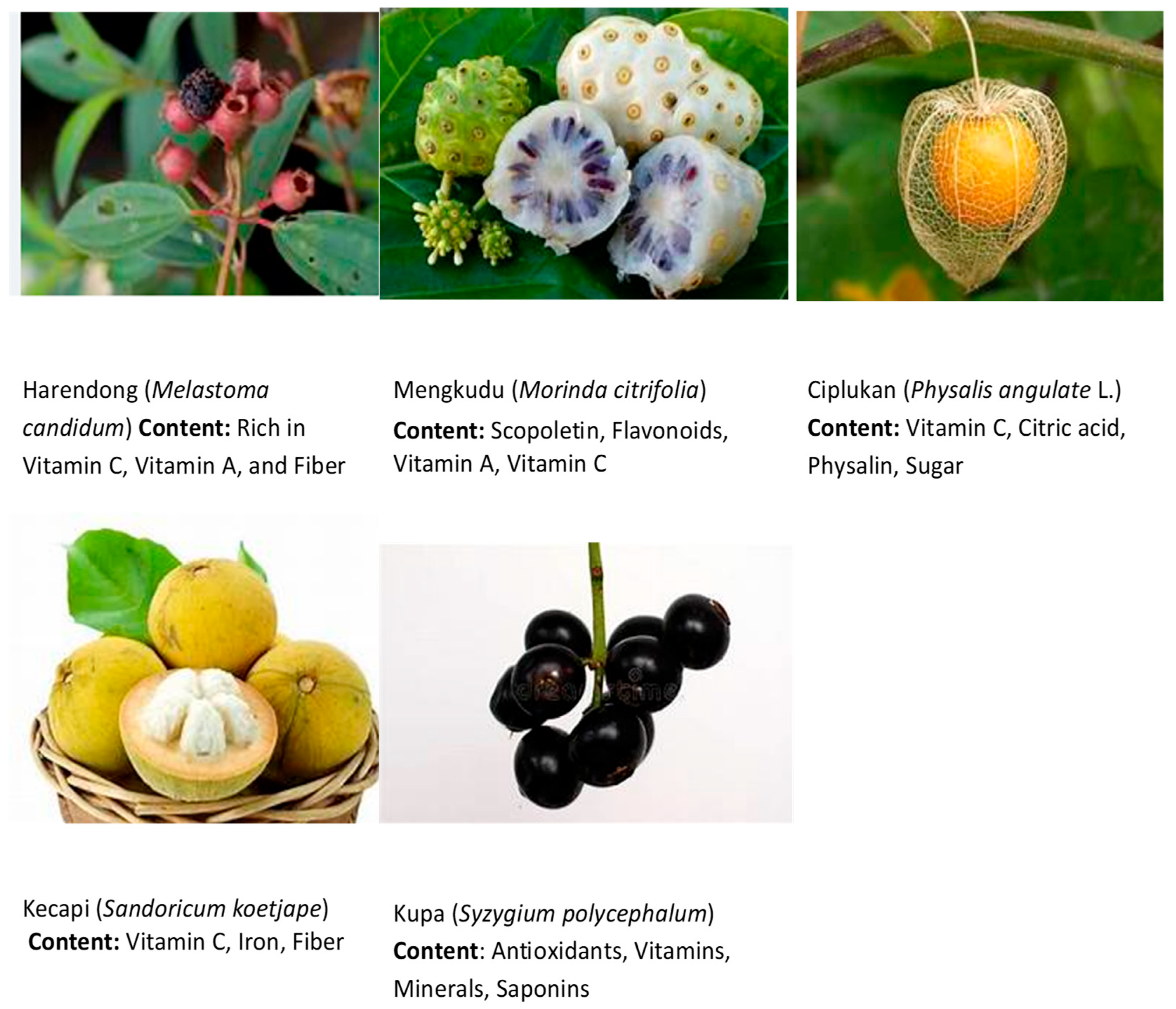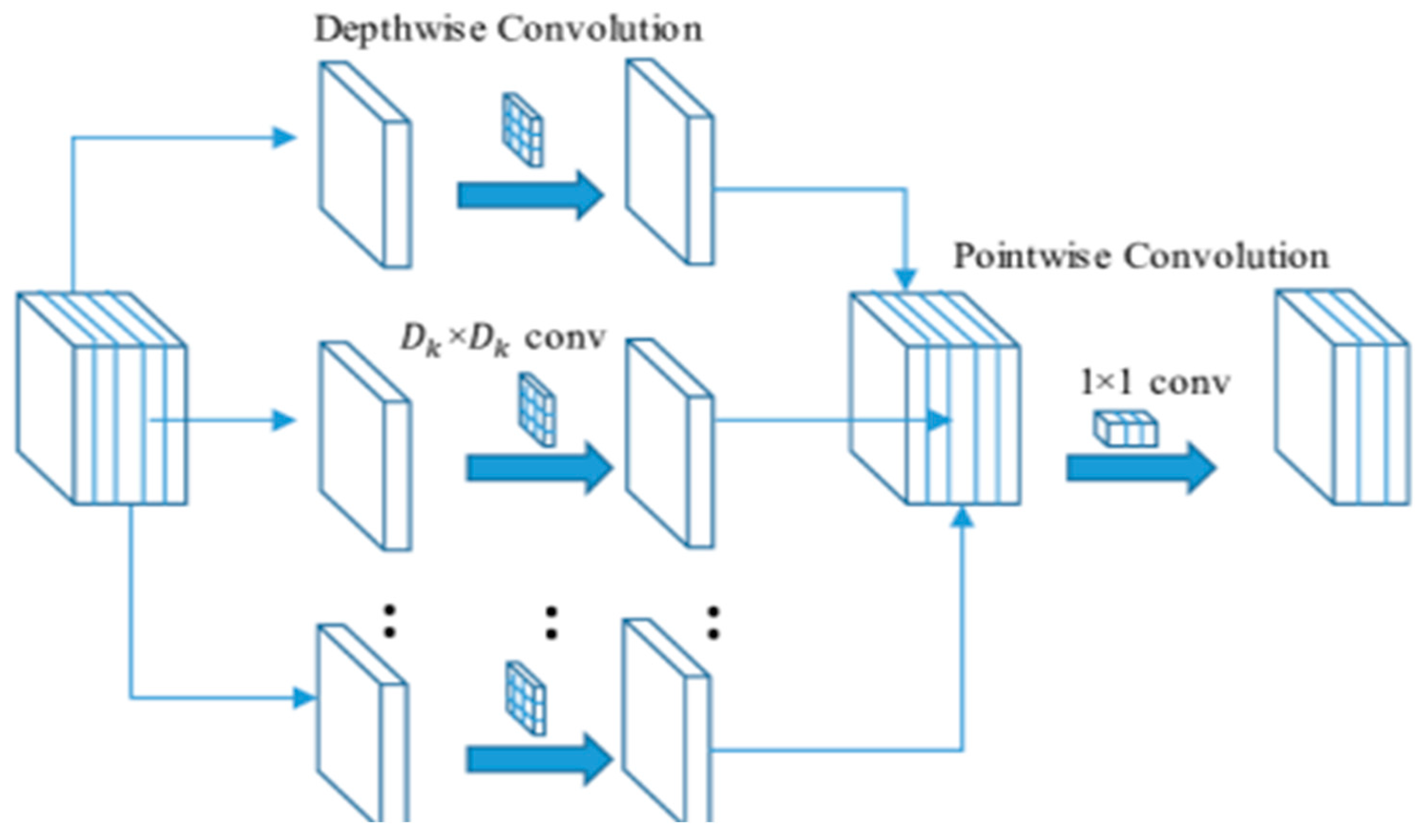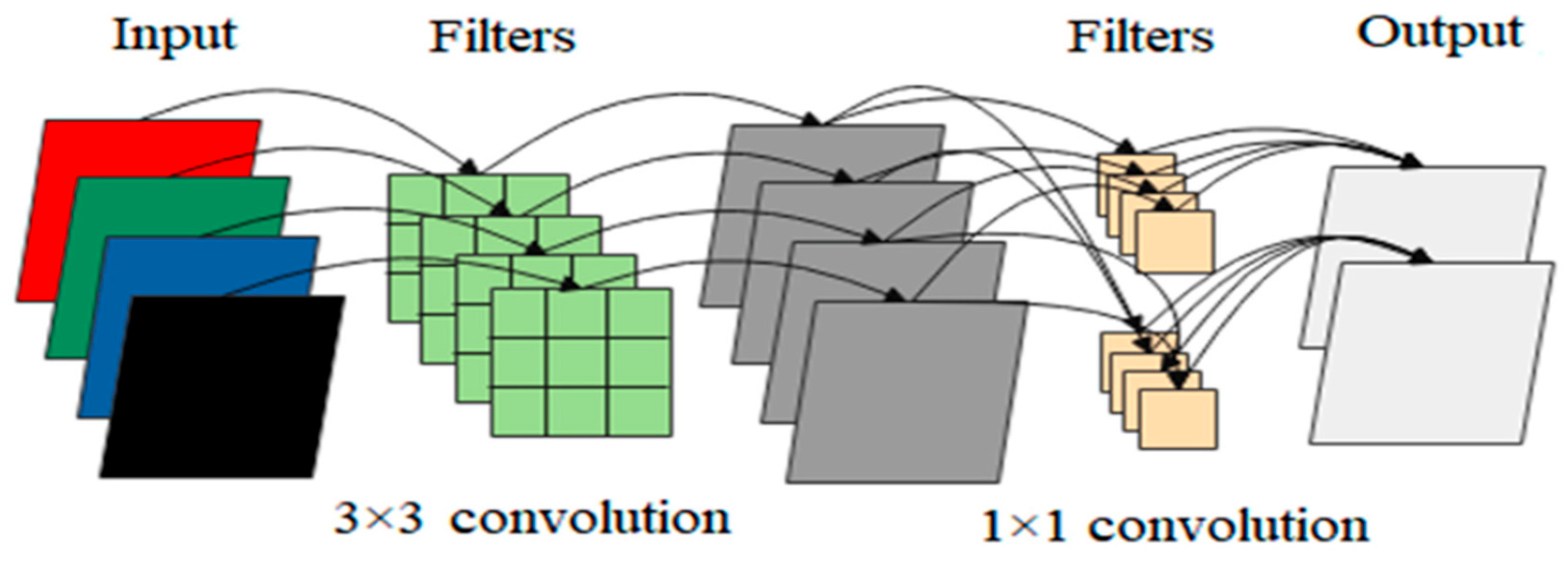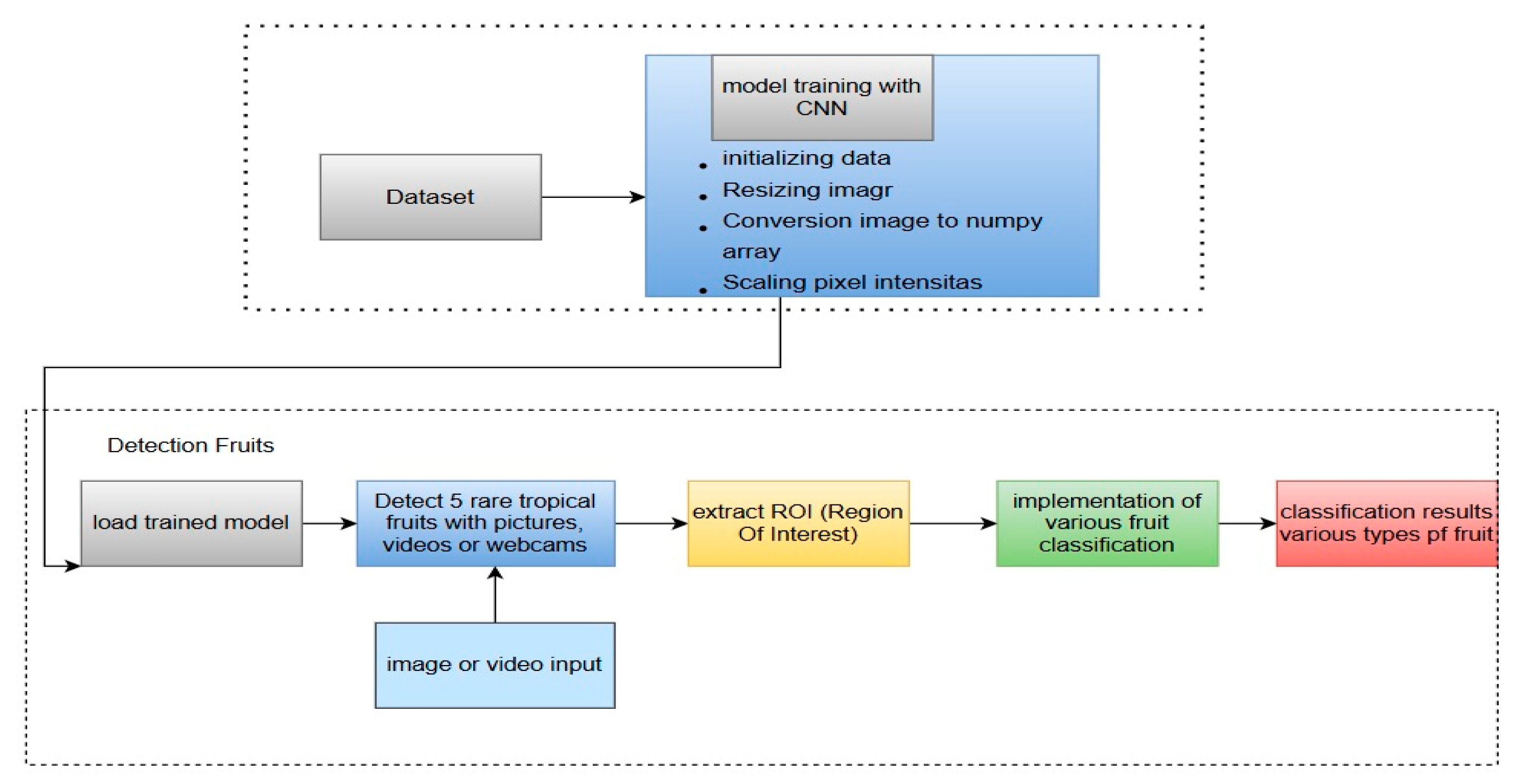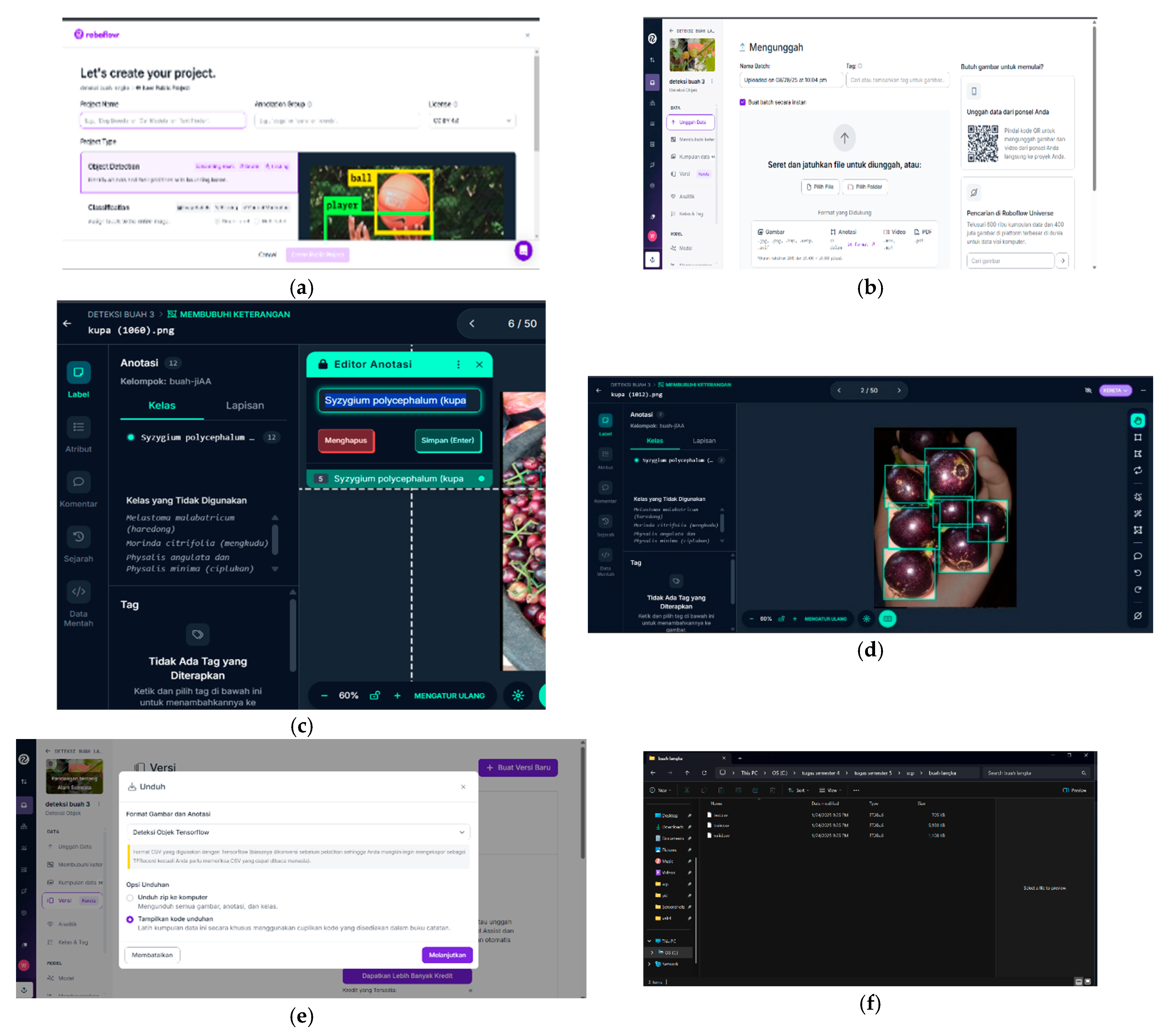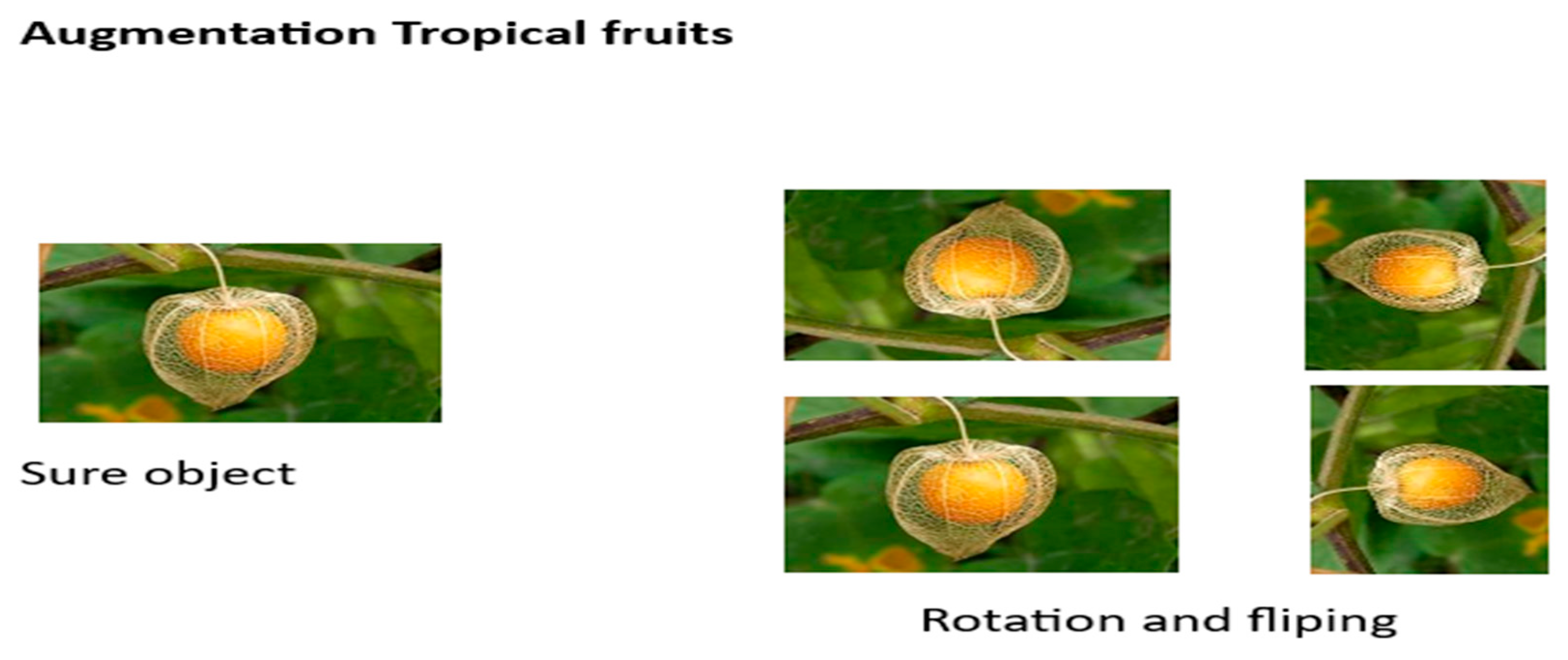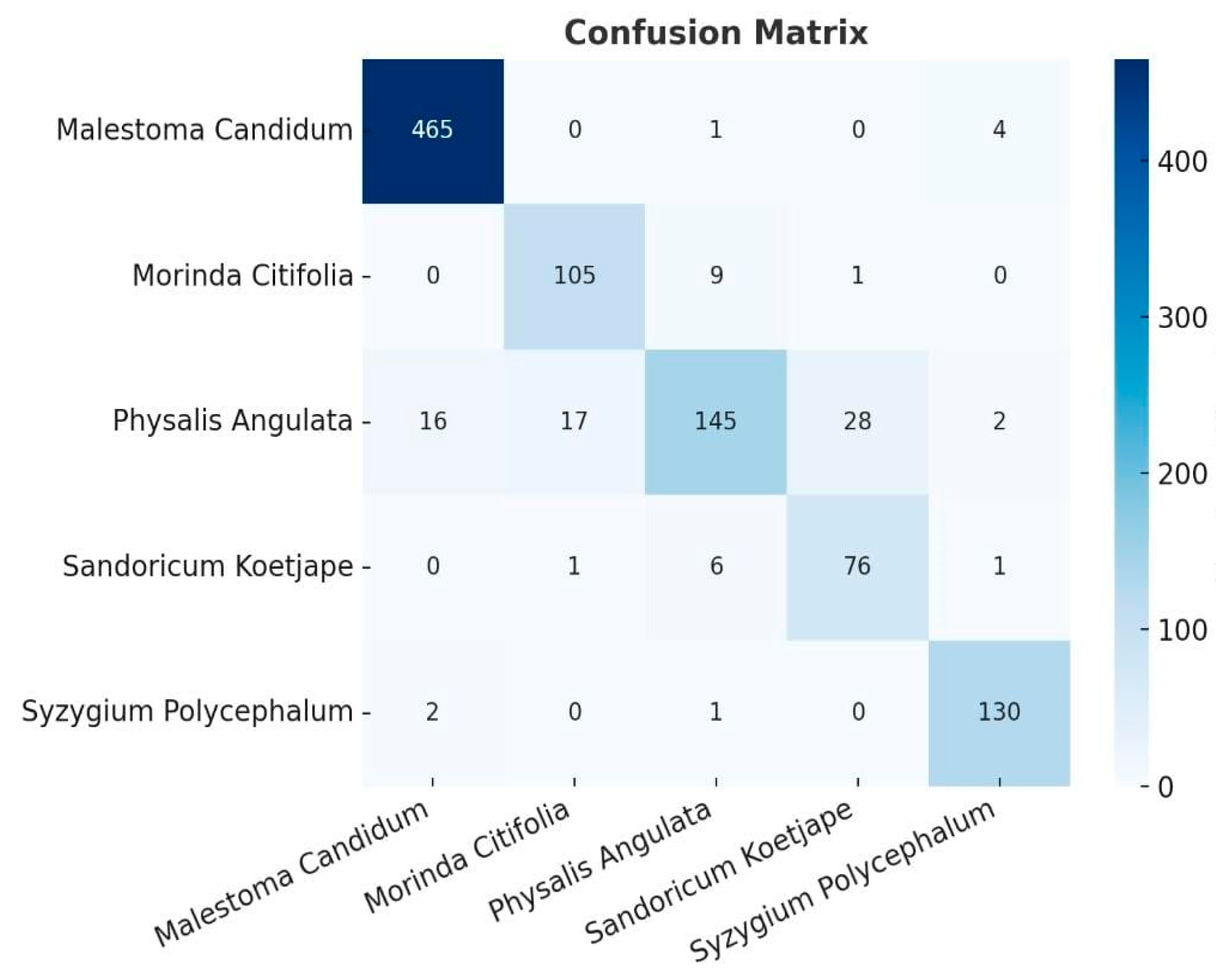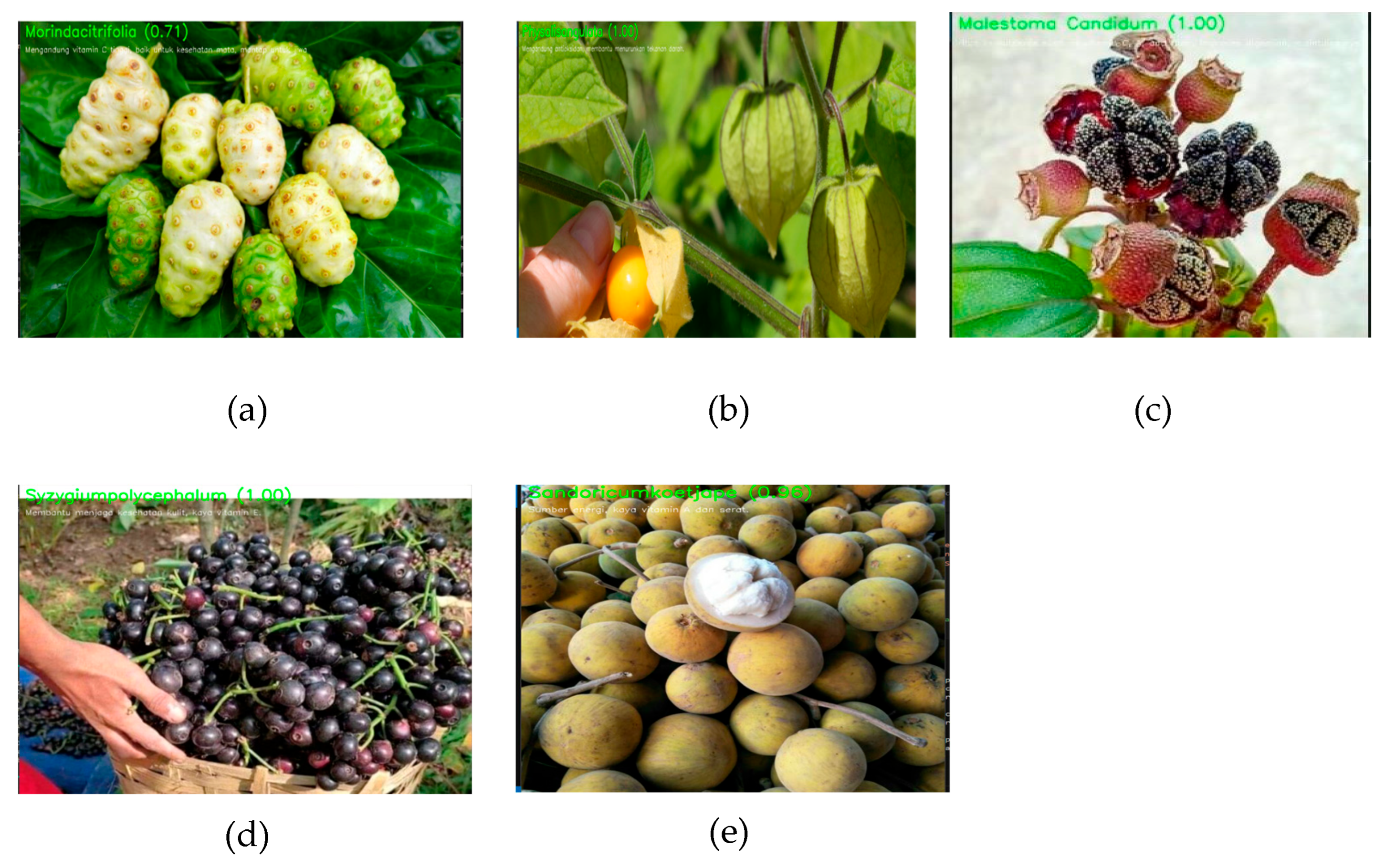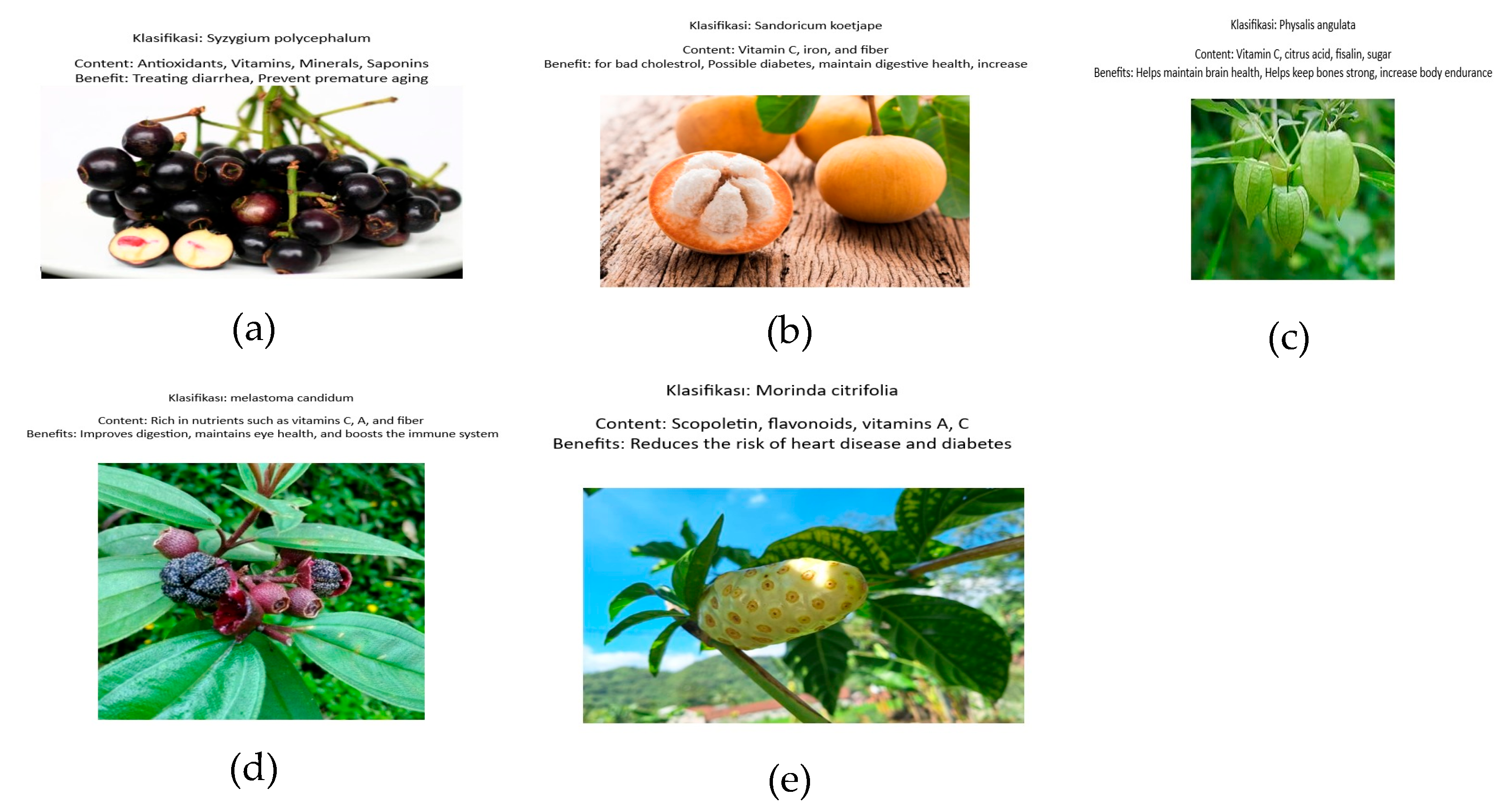1. Introduction
Indonesia’s biodiversity is very diverse. Tropical fruits with various contents and health benefits are one of the biological riches that can be found in various regions of Indonesia [
1]. It is very possible to use tropical fruits such as kecapi (
Sandoricum koetjape), harendong (
Melastoma candidum), kupa (
Syzygium poly-cephalum), mengkudu (
Morinda citrifolia), and ciplukan (
Physalis angulate L.) as natural medicines, functional foods, and other health products [
2]. However, people often do not know the properties, benefits and characteristics of these tropical fruits [
3]. A great opportunity to help the process of identifying and classifying objects, including fruits, has emerged as a result of advances in artificial intelligence technology, especially deep learning [
4]. Convolutional Neural Network (CNN), which has proven effective in recognizing and classifying objects in digital images, is one approach that can be used [
5]. By using images taken with a camera. CNN can be used to find various types of fruit. To identify the fruits, their visual characteristics shape, size, color, and texture, are used [
6].
Since MobileNet is made for low-resource devices, and it enables a highly accurate classification process while conserving resources, it provides a great solution for mobile device applications [
7]. In this study, MobileNet is combined with a camera to create a system that can recognize different types of eggplant, harendong, nutmeg, mengkudu, and ciplukan, as well as provide details on their contents and advantages [
8]. It is envis-aged that this approach will be a realistic and effective option for recognizing and exploiting local and tropical Indonesian fruits [
9]. This study aims to develop a deep learn-ing-based system that uses the MobileNet method to identify local fruit types and provide information on their content and benefits [
10]. This approach is expected to achieve a high level of accuracy even in non-ideal image situations. It is also hoped that this system will be a useful tool to encourage wider use of local Indonesian fruits [
11].
2. Related Works
2.1. Previous Related Research
Previous research on the detection of familiar fruit types such as oranges and apples focused on identifying fruit names for images [
12]. The types of fruit to be detected are shown in
Figure 1.
In contrast, this study focuses on five types of tropical fruits as shown in
Figure 1, specifically, these are kecapi (
Sandoricum koetjape), harendong/senggani (
Melastoma candidum), kupa (
Syzygium polycephalum), mengkudu (
Morinda citrifolia), and ciplukan (
Physalis angulate L.) using the MobileNetV2 algorithm can determine the effectiveness value of each object.
2.2. Algoritma MobileNet
MobileNet is a family of convolutional neural network (CNN) architectures designed for resource-constrained devices such as mobile phones and IoT devices [
13]. MobileNet was first introduced by researchers at Google in 2017. The algorithm uses a Depthwise Separable Convolution approach to reduce the number of parameters and computations required, allowing for lightweight and efficient network implementations [
14].
MobileNet has several major versions, namely MobileNetV1, MobileNetV2, and Mo-bileNetV3. Each version brings improvements in computational efficiency and accuracy. MobileNetV2, for example, introduces the Inverted Residual and Linear Bottleneck blocks, while MobileNetV3 uses the NAS (Neural Architecture Search) technique to obtain the optimal architecture [
15]. As shown in
Figure 2, MobileNet consists of three main parts, namely Depthwise Convolution, Pointwise Convolution, and Activation Function.
In simple terms, MobileNet utilizes the Depthwise Separable Convolution process to separate the convolution into two steps. First, performs filtering for each input channel separately. Then Pointwise Convolution uses a 1 × 1 filter to combine information from these channels. This combination reduces the computational burden significantly compared to traditional convolution [
17], as shown in
Figure 3.
In this study, MobileNet was chosen over other models such as ResNet or Inception because of its efficiency on low-power devices and its sustainability as a lightweight model [
18]. For example, MobileNetV2 has an advantage in the trade-off between inference speed and detection accuracy compared to ResNet, which is more computationally intensive [
19]. While models such as Inception are more suitable for servers with high computing power, MobileNet offers the flexibility to be implemented on mobile devices or edge devices. This makes MobileNet an ideal choice for real-time applications such as face detection, image classification, or camera-based surveillance systems [
20].
2.3. Tropical Fruit
Tropical fruits are those that commonly grow in countries located along the Earth’s equator. Below are descriptions of several types of tropical fruits and their characteristics:
2.3.1. Kecapi (Sandoricum koetjape)
Kecapi is a tropical fruit originating from Southeast Asia, with a medium to large size, a round shape, and thick skin covered with fine hairs. The flesh of the fruit is white and has a sweet and sour taste. It usually has large seeds in the middle. It is rich in vitamin C and calcium and is often used as an ingredient in drinks and snacks [
21].
2.3.2. Harendong (Melastoma candidum)
Harendong is a blackish purple fruit with soft flesh that grows on tropical shrubs. It is small in size, with a diameter of about 1–2 cm. It is rich in antioxidants, especially anthocyanins, which are good for body health. In addition, it is also often used as a natural dye [
22].
2.3.3. Kupa (Syzygium polycephalum)
Kupa is a tropical fruit that has a small round shape with a yellowish green color when ripe. This fruit has a sweet and sour taste and a distinctive aroma. It is often used in making sweets, jams, or consumed directly as fresh fruit. Its nutritional content includes vitamin C, fiber, and phenolic compounds which act as antioxidants [
23].
2.3.4. Mengkudu (Morinda citrifolia)
Mengkudu, also known as noni, is known as a medicinal fruit with a distinctive aroma and bitter taste. This fruit is medium sized and has a green color that turns yellowish when ripe. It is rich in bioactive compounds such as scopoletin, alkaloids, and iridoids, which have various health benefits, including improving the immune system and helping overcome inflammation [
24].
2.3.5. Ciplukan (Physalis angulate L.)
Ciplukan is a small fruit wrapped in a lantern-like calyx. It has a sweet taste when ripe and a golden yellow color. It is often used as a healthy snack or as an additional ingredient in salads. It is rich in vitamin A and C, as well as phytochemical compounds such as flavonoids, which are beneficial for eye and skin health [
25]. The diversity of tropical fruits highligths importance of preserving them to prevent extinction and remain ensure their benefits for future generations. The life cycle and growth of each fruit can be studied further to support conservation efforts [
26].
3. Materials and Methods
The performance of the MobileNetV2 model in rare fruit detection is shown in
Figure 4, which illustrates the fruit images along with their content and benefits for living beings.
Figure 4 shows the research stages, which are carried out sequentially from start to finish and are interconnected.
3.1. Dataset Retrieval
The initial stage of this research involves collecting image data from Roboflow [
27] which provides datasets for computer vision and APIs. The dataset will include five classes or labels on rare fruit species, namely kecapi (
Sandoricum koetjape), harendong (
Melastoma candidum), kupa (
Syzygium polycephalum), mengkudu (
Morinda citrifolia), and ciplukan (
Physalis angulate L). This rare fruit is plant that contains many beneficial compounds for humans.
This image dataset will be used to train and evaluate a MobileNetV2-based object detection model.
There are multiple types of tropical fruits with health benefits. For example, one of the rare fruits that with benefits is kecapi, scientifically known as Sandoricum koetjape. Other example are harendong (Melastoma candidum), kupa (Syzygium polycephalum), mengkudu (Morinda citrifolia), and ciplukan (Physalis angulate L.), the content and benefits of these rare fruits are very abundant. This image dataset will be used to train and evaluate the MobileNetV2-based object detection model.
The dataset in this study consists of 5000 tropical fruit images obtained from self-collection and labeled in Roboflow, which are categorized into five classes: kecapi (
Sandoricum koetjape), harendong (
Melastoma candidum), kupa (
Syzygium polycephalum), mengkudu (
Morinda citrifolia), and ciplukan (
Physalis angulate L.). Each class contains about 1000 images with a standard size of 224 × 224 pixels. The dataset covers a variety of lighting conditions, backgrounds, and viewing angles to ensure that the model can detect rare fruits, as shown in
Figure 5:
After the images are collected, the next stage labeling them. Then the objects in the image are labelled using Roboflow as described, in so that it can speed up and simplify the labeling process so that it produces a dataset that is in accordance with expectations. The labeling process is shown in
Figure 6:
In
Figure 6, Roboflow is shown as a tool that simplifies the creation of image label for datasets. The process is straight forward: prepare the image files, next import them, finally label the objects with according to the desired object class.
Data augmentation involves artificially increasing the size of the training dataset by slightly transforming the existing images. This technique enhances the dataset with minimal effort by applying transformations such as cropping and flipping without changing the original data identifiers. This is a cost-effective way to expand data for training models as shown in
Figure 7.
Data Splitting is the process of dividing a dataset into several subsets for training, validation, and testing of an object detection model, or can be said to be a stage for essentially separating training data from the test data.
3.2. Training Data
In this study, the dataset of 5000 images across five classes (kecapi (Sandoricum koetjape), harendong (Melastoma candidum), kupa (Syzygium polycephalum), mengkudu (Morinda citrifolia), and ciplukan (Physalis angulate L.), was divided into 70% for training (3485 images per class), 20% for validation (1010 per class), and 10% for testing (505 images per class), with all images resized to 224 × 224 pixels. The MobileNet V2 model was trained with a batch size of 16,300 epochs, and an initial learning rate of 0.01, which decreased by 10% every 50 epochs to prevent overfitting and ensure stable convergence. The training took approximately 3 and 5 h per model on Google Colab with GPU, depending on hardware and optimization. MobileNetV2 Nano requires 2 GB of memory.
For low-source devices, MobileNetV2 requires GPU (e.g., NVIDIA Jetson Nano or Intel Integrated GPU), a dual-core processor, and 2 GB of RAM; for mid-range use requires a 2 GB GPU (e.g., NVIDIA Jetson Nano or GTX 1050), a quad-core processor, and 4 GB of RAM for high-accuracy applications, it requires 4 GB GPU (e.g., GTX 1650 or RTX 2050), a quad-core processor, and 8 GB of RAM.
After dividing the dataset into training, validation, and testing subsets, the model’s performance is evaluated using the following metrics : Accuracy (A), Precision (P), Recall (R), F1-Score (F1), and Mean Average Precesion (mAP) according to standard formula.
4. Results and Discussion
Testing was conducted on the previously created dataset using the Google Colab training process. The dataset consist of 5000 images divided into five classes of kecapi (
Sandoricum koetjape), harendong (
Melastoma candidum), kupa (
Syzygium polycephalum), mengkudu (
Morinda citrifolia), and ciplukan (
Physalis angulate L.) with 3485 images per class for training, 1010 for validation, and 505 for testing. All images are size is 224 × 224 pixels. Testing performed over 50 epochs using MobileNetV2 data augmentation for Tropical fruit nutrition classification. A threshold of 0.25 was applied. Then resultings performance of the MobileNetV2 model is shown in the following
Figure 8.
4.1. MobileNetV2 Augmentation
Testing the dataset with the MobileNetV2 model using the Convolutional Neural Network method produced the results shown in
Table 1:
Table 1 shows the results obtained from testing the MobileNetV2 model, highlighting that Precision has a value of 0.97, Recall has a value of 0.98, F1-score has a value of 0.98 and support has a value of 1010. The Precision value of 0.97 indicates that 97% of the detections made by the model are correct , demonstrating that the model performs well with relatively accurate predictions. However, this also means that there is still room for improvement, as almost half of the detections may be inaccurate. The Recall value of 0.98 indicates that the model correctly identified 98% of all instance in the testing dataset. The training accuracy results using MobileNetV2 as shown in
Table 2.
Table 2 presents the training and validation accuracy results with the model achieving 99.99% accuracy on the training set and 97.43% on the validation set.
We performed additional visualization using the Confusion Matrix method to assess the model’s performance by showing the number of correct and incorrect predictions for each tropical fruit class. This matrix helps in understanding how well the model correctly recognizes each class (True Positives).
Figure 9 presents the result obtained from the MobileNetV2 model”.
These metrics collectively indicate that the MobileNetV2 model exhibits reasonable proficiency in detecting tropical fruits, nevertheless there is a clear need for improvement in its predictive accuracy and consistency across different bounding box precision levels. Improvement in these aspects will help in achieving more reliable and accurate detection results, ultimately making the model more effective for practical applications. The superior detection values highlight its potential to deliver better detection performance.
4.2. Tropical Fruits Nutrition Classification
The nutritional classification of tropical fruits aims to analyze the nutritional content of various types of fruits and their associated health benefits. In this study, an analysis was conducted on five types of tropical fruits, namely kecapi (
Sandoricum koetjape), harendong (
Melastoma candidum), kupa (
Syzygium polycephalum), mengkudu (
Morinda citrifolia), and ciplukan (
Physalis angulata L.).” The results of the tropical fruit classification as shown in
Figure 10.
Each fruit has a unique nutritional composition, such as vitamins, minerals, antioxidants, and other bioactive compounds. For example, mengkudu is known for its anti-inflammatory properties, while ciplukan has a high antioxidant content. The classification analysis was carried out based on the main nutritional parameters to group these fruits into their appropriate categories. The method used in this classification considers the physical and chemical characteristics of each fruit, such as air content, fiber, sugar, and phytochemical content. With this approach, the classification results can help in understanding the potential health benefits of these tropical fruits and their applications in the fields of food and health.
5. Conclusions
This study tested the performance of the MobileNetv2 model in classifying five types of tropical fruits, namely kecapi (Sandoricum koetjape), harendong (Melastoma candidum), kupa (Syzygium polycephalum), mengkudu (Morinda citrifolia), and ciplukan (Physalis angulata L.), using a dataset of 5000 images, each size 224 × 224 pixels. The model was trained for 50 epochs, employing augmentation techniques to enhance performance.
The test results show that the MobileNetV2 model has high performance, with a Precision value of 0.97, a Recall score of 0.98, and F1-score of 0.98 for all classes. The training accuracy reached 99.00%, while the validation accuracy was 97.43%. The Confusion Matrix indicates that the model successfully recognizes most classes, although some classification errors remain.
In addition to image classification, this study analyzed the nutritional composition of tropical fruits based on physical and chemical parameters such as water, fiber, sugar, and phytochemical content. This analysis provides insigths into the health benefits of each fruit and its potential application in the food and health industries. Although the model performed well, there remain room for improvement, particularly in enhancing detection accuracy and classification consistency under varying conditions. Further research could focus on optimizinge augmentation techniques or exploringe alternative models to achieve more accurate and reliable results.
Author Contributions
Conceptualization, A.S.; methodology, J.A. and A.S.; data curation, W.W.; software, J.A.; validation, A.S.; visualization, W.W.; writing, A.S. and W.W.; funding acquisition, J.A. and G.P.I.; supervision, G.P.I.; review and editing, G.P.I. All authors have read and agreed to the published version of the manuscript.
Funding
This research received no external funding.
Institutional Review Board Statement
Ethical review and approval were waived for this study due to the data were obtained from publicly available datasets.
Informed Consent Statement
Not applicable.
Data Availability Statement
The data are not publicly available due to privacy or ethical restrictions.
Conflicts of Interest
The authors declare no conflict of interest.
References
- Harun Haruna, M.F.; Kenta, A.M.; Herawati, H. Medicinal plants used by the community of Lipu-lalongo Village, Banggai Laut District, Central Sulawesi, Indonesia. Asian J. Ethnobiol. 2022, 5, 62–68. [Google Scholar] [CrossRef]
- Kumoro, A.C.; Alhanif, M.; Wardhani, D.H. A Critical Review on Tropical Fruits Seeds as Prospective Sources of Nutritional and Bioactive Compounds for Functional Foods Development: A Case of Indonesian Exotic Fruits. Int. J. Food Sci. 2020, 2020, 4051475. [Google Scholar] [CrossRef]
- Belmonte-Herrera, B.H.; Domínguez-Avila, J.A.; Wall-Medrano, A.; Ayala-Zavala, J.F.; Preciado-Saldaña, A.M.; Salazar-López, N.J.; López-Martínez, L.X.; Yahia, E.M.; Robles-Sánchez, R.M.; González-Aguilar, G.A. Lesser-Consumed Tropical Fruits and Their by-Products: Phytochemical Content and Their Antioxidant and Anti-Inflammatory Potential. Nutrients 2022, 14, 3663. [Google Scholar] [CrossRef]
- Florkowski, M. Classification of partial discharge images using deep convolutional neural networks. Energies 2020, 13, 5496. [Google Scholar] [CrossRef]
- Ayeni, J.A. Convolutional Neural Network (CNN): The architecture and applications. Appl. J. Phys. Sci. 2022, 4, 42–50. [Google Scholar] [CrossRef]
- Pillagolla Jayakrishna, M.; Naveen, M. Improved Fruit Detection by Image Processing Using Deep Learning. IEEE Access. Available online: https://www.semanticscholar.org/paper/Improved-Fruit-Detection-by-Image-Processing-using-Jayakrishna-Naveen/68a385bafd4b2fe4101f88bdd9f5febff34fc5a5 (accessed on 23 May 2025).
- Dey, M.R.K.U.C.; Hasan, F.; Papel, M.H.R.; Turza, T.H.; Hasan, M.M. Local Fruit Classification and Recognition Using Transfer Learning Models. In Proceedings of the International Conference on Computing Communication and Net-Working Technologies; Available online: https://www.semanticscholar.org/paper/Local-Fruit-Classification-and-Recognition-using-DeyHasan/62660cd1ca7560e5a120887f049514ba4c4aacfe (accessed on 23 May 2025).
- Sugiarto, D.; Siswantoro, J.; Naufal, M.F.; Idrus, B. Mobile Application for Medicinal Plants Recognition from Leaf Image Using Convolutional Neural Network. Indones. J. Inf. Syst. 2023, 5, 43–56. [Google Scholar] [CrossRef]
- Ravindran, K.M.; Jones, P.J.; Rayment, M. Can Underutilized Tropical Fruits Meet the Nutritional Requirements of Rural Indonesia? Indones. J. Innov. Appl. Sci. 2021, 1, 151–160. [Google Scholar] [CrossRef]
- Xalo Rancaño, J.F.; Fernández Molanes, R.; González-Val, C.; Rodríguez-Andina, J. Performance Evaluation of State-of-the-Art Edge Computing Devices for DNN Inference. In Proceedings of the IECON 2020—The 46th Annual Conference of the IEEE Industrial Electronics Society; Available online: https://www.semanticscholar.org/paper/Performance-Evaluation-of_State-of-the-Art-Edge-for-Rancaño-lanes/40c4bcf51a0a6d3e40bf5aa353a899cf928d5bc1 (accessed on 23 May 2025).
- Tapia-Mendez, E.; Cruz-Albarran, I.A.; Tovar-Arriaga, S.; Morales-Hernandez, L.A. Deep Learning-Based Meth-od for Classification and Ripeness Assessment of Fruits and Vegetables. Appl. Sci. 2023, 13, 12504. [Google Scholar] [CrossRef]
- Ukwuoma, C.C.; Zhiguang, Q.; Bin Heyat, M.B.; Ali, L.; Almaspoor, Z.; Monday, H.N. Recent Advancements in Fruit Detection and Classification Using Deep Learning Techniques. Math. Probl. Eng. 2022, 2022, 9210947. [Google Scholar] [CrossRef]
- Poonam Shourie, G.; Anand, V. Seven Class Skin Disease Classification using Pre-trained MobileNet Network. In Proceedings of the 2023 International Conference on Innovations in Engineering and Technology (ICIET), Muvattupuzha, India, 13–14 July 2023; pp. 1–5. [Google Scholar] [CrossRef]
- Glegoła, W.; Karpus, A.; Przybyłek, A. MobileNet family tailored for Raspberry Pi. Procedia Comput. Sci. 2021, 192, 2249–2258. [Google Scholar] [CrossRef]
- Yao, D.; Xu, Y.; Zhang, C.; Xu, Z.; Huang, J.; Guo, B. Lightweight Crowd Counting Network based on Depthwise Separable Convolution. J. Phys. Conf. Ser. 2020, 1634, 012016. [Google Scholar] [CrossRef]
- Siva Subramanyam, S.C.; Kameswar, N.S.S.P.; Yuva Teja, K.; Madhu Sai Varma, K.; Govind, M. Deep Learning Approach for Yoga Posture Evaluation. Int. J. Adv. Res. Sci. Commun. Technol. 2024, 4, 83–92. [Google Scholar] [CrossRef]
- Ghimire, D.; Kil, D.; Kim, S.H. A Survey on Efficient Convolutional Neural Networks and Hardware Acceleration. Electronics 2022, 11, 945. [Google Scholar] [CrossRef]
- Schwarz Schuler, J.P.; Also, S.R.; Puig, D.; Rashwan, H.; Abdel-Nasser, M. An Enhanced Scheme for Reducing the Complexity of Pointwise Convolutions in CNNs for Image Classification Based on Interleaved Grouped Filters without Divisibility Constraints. Entropy 2022, 24, 1264. [Google Scholar] [CrossRef]
- Harahap, S.A.F.; Irmawan, I. Performance comparison of MobileNet, EfficientNet, and Inception for predicting crop disease. Sriwij. Electr. Comput. Eng. J. 2024, 1, 30–36. [Google Scholar] [CrossRef]
- Yang, F. Enhancing Concrete Crack Image Detection Using MobileNetV2 and Transfer Learning. Front. Sci. Eng. 2024, 4, 110–119. [Google Scholar] [CrossRef]
- Kim, C.Y.; Um, K.S.; Heo, S.W. A novel MobileNet with selective depth multiplier to compromise complexity and accuracy. ETRI J. 2023, 45, 666–677. [Google Scholar] [CrossRef]
- Suhendy, H.; Astuti, N.; Gustaman, F. Kajian Fitokimia Pigmen Warna Ungu dan Profil Antioksidan pada Ekstrak Bunga Harendong (Melastoma malabathricum L.). J. Pharmacopolium 2022, 5, 155–163. [Google Scholar] [CrossRef]
- Fauziyah, R.; Mulqie, L.; Choesrina, R. Studi Literatur Aktivitas Antibakteri Buah Mengkudu (Morinda citrifolia). Bandung Conf. Ser. Pharm. 2022, 2, 1–5. [Google Scholar] [CrossRef]
- Fadhli, H.; Ruska, S.L.; Furi, M.; Suhery, W.N.; Susanti, E.; Nasution, M.R. Ciplukan (Physalis angulata L.): Review Tanaman Liar yang Berpotensi Sebagai Tanaman Obat. JFIOnline 2023, 15, 134–141. [Google Scholar] [CrossRef]
- Kaviani, B.; Kulus, D. Cryopreservation of Endangered Ornamental Plants and Fruit Crops from Tropical and Subtropical Regions. Biology 2022, 11, 847. [Google Scholar] [CrossRef] [PubMed]
- Raju, C.; Pazhanivelan, S.; Perianadar, I.V.; Kaliaperumal, R.; Sathyamoorthy, N.K.; Sendhilvel, V. Climate Change as an Existential Threat to Tropical Fruit Crop Production—A Review. Agriculture 2024, 14, 2018. [Google Scholar] [CrossRef]
- Akhsan, W.; Solihah, J.; Widasari, A. Rare or Tropical Fruit Detection Labeling Dataset in Roboflow. Available online: https://universe.roboflow.com/deteksi-buah-langka/deteksi-buah-zonuw (accessed on 30 March 2025).
| Disclaimer/Publisher’s Note: The statements, opinions and data contained in all publications are solely those of the individual author(s) and contributor(s) and not of MDPI and/or the editor(s). MDPI and/or the editor(s) disclaim responsibility for any injury to people or property resulting from any ideas, methods, instructions or products referred to in the content. |
© 2025 by the authors. Licensee MDPI, Basel, Switzerland. This article is an open access article distributed under the terms and conditions of the Creative Commons Attribution (CC BY) license (https://creativecommons.org/licenses/by/4.0/).
